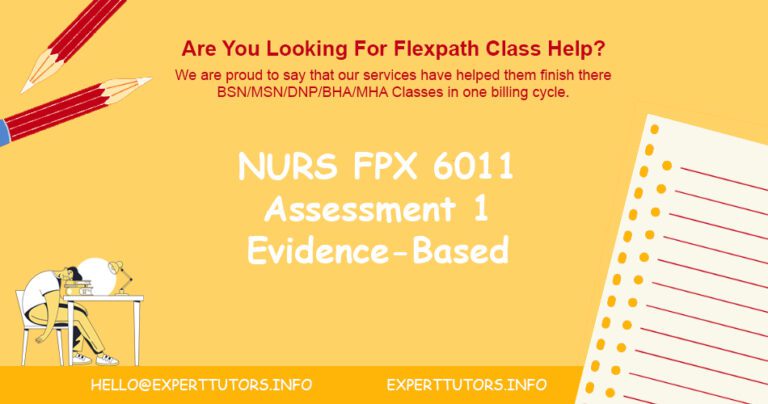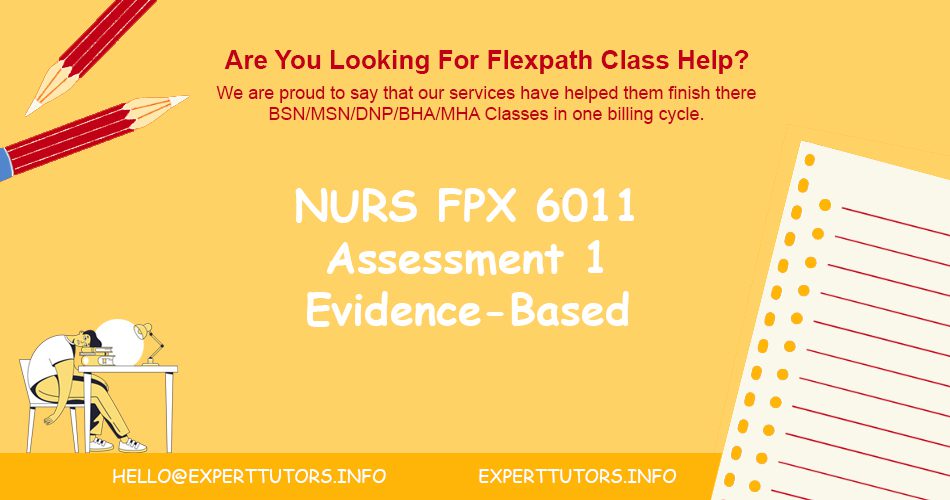Name
Capella University
NURS FPX 6011
Dr. Name
April, 2024
Evidence-Based Patient-Centered Needs Assessment
The need assessment explores and substantiates healthcare technology implementation to enhance patient engagement and improve outcomes for a specific patient population. The focus on technology, such as telehealth platforms, mobile health applications, and wearable devices, is intended to address distinct needs within this group, ranging from chronic disease management to preventive care. By leveraging current evidence and best practices, the assessment outlines a strategic approach to integrating innovative solutions that meet the patient’s unique health, economic, and cultural needs, optimizing care delivery and promoting better health outcomes. This document serves as a blueprint for healthcare providers to effectively plan and execute technology-driven interventions tailored to the identified needs of the community served (Alsahli et al., 2023).
Importance of Patient Engagement and Evidence-Based Strategies
Addressing patient engagement in managing specific health, economic, and cultural needs is crucial for optimizing healthcare outcomes. The integration of patient engagement strategies ensures that care is not only reactive but also proactive, focusing on holistic wellness that encompasses a patient’s complete lifestyle and environment. Evidence-based practice highlights the significance of tailored engagement strategies that consider diverse patient backgrounds and circumstances, leading to more effective management of chronic conditions and improved overall health outcomes. Studies consistently indicate that patients who are engaged are more likely to comply with treatment plans, participate in preventive care, and achieve better health outcomes (Modi & Feldman, 2022).
For example, implementing a digital health monitoring system can significantly improve patient engagement by allowing continuous interaction between patients and healthcare providers. Such a system can be especially effective for patients managing chronic diseases such as diabetes, where regular monitoring and adjustments in lifestyle and medication are necessary. Additionally, culturally sensitive health education programs that respect and incorporate the values and beliefs of different ethnic groups can enhance patient understanding and cooperation. Various formats such as mobile apps, webinars, or community workshops are used to deliver these programs, making them accessible and relevant to the patient’s specific cultural context (Curran et al., 2023).
Utilization and Impact of ICT Tools on Health Literacy
The use of information and communication technology (ICT) tools has a significant potential to improve consumer health literacy, especially in patient populations that face obstacles to traditional health education methods. Tools like mobile health applications, patient portals and online health resources give patients the power to access, comprehend, and act on health information that is easy to understand and accessible. For instance, studies have demonstrated that patient portals that offer access to personal health records can significantly increase patient engagement and self-management capabilities, particularly in chronic disease scenarios (Wosny et al., 2023). These portals allow patients to track their medical history, medication, and test results, enabling them to make informed decisions about their health care.
However, while ICT tools are promising, they also present areas of uncertainty that need further exploration to optimize their use. For example, there remains a question about the level of health literacy required to effectively use these tools. Patients with limited literacy or technological skills may find sophisticated apps and portals challenging to navigate. Additionally, the personalization of these tools to meet the diverse cultural and linguistic needs of different patient populations is not well understood. More research is needed to determine how these technologies can be adapted to be more inclusive and accessible to all users, regardless of their educational background or native language (Chidambaram et al., 2024). Identifying these gaps and addressing them through continuous improvement and tailored educational support could significantly enhance the effectiveness of ICT interventions in improving health literacy.
Evaluation of Technology Modalities for Patient Needs and Communication Strategies
The selection and implementation of technology modalities in healthcare are critical to addressing the identified needs of specific patient populations. The value and relevance of these technologies—such as telehealth services, electronic health records (EHRs), and personalized health apps—are assessed based on their ability to enhance patient care, improve accessibility to healthcare services, and facilitate better health management. For instance, telehealth services extend the reach of healthcare providers, allowing patients in remote or underserved areas to receive timely medical consultations and follow-ups. Electronic Health Records (EHRs) facilitate the sharing of patient data among healthcare providers to ensure continuity of care. The interoperability of EHRs with other technology systems greatly enhances their value. Health Information Exchange (HIE) systems enable real-time sharing of patient data across various healthcare settings, promoting coordinated care and emergency interventions (Leonardsen et al., 2020). This interoperability helps to deliver consistent, timely, and informed care based on a comprehensive view of the patient’s medical history.
In addition, the methods of communication utilized by these technologies are crafted to maintain the values of sincerity and clarity. Patient portals with secure messaging systems make certain that the exchange of information between patients and providers follows the rules of confidentiality, safeguarding confidential information, and promoting honest conversations about the patient’s health issues. These platforms also offer features like message translation and the use of layman’s terms to describe complex medical conditions and treatments, making the information accessible to individuals regardless of their language proficiency or educational background. Carefully evaluating these technology modalities and their implementation can significantly contribute to personalized and effective patient care, ensuring that all interactions are secure, private, and understandable to the patient and their family (Cao et al., 2022).
Strategies for Technology in Culturally and Linguistically Appropriate Patient Care
In order to ensure that services are culturally and linguistically appropriate for diverse patient populations, it is crucial to implement innovative strategies that leverage technology to support quality, ethical, and efficient patient care. One effective strategy is using customized patient education platforms that adapt content based on the user’s language and cultural background. These platforms can include multilingual interfaces and culturally relevant health information, which are critical for enhancing patient understanding and engagement. For example, a study demonstrated the effectiveness of a multilingual mobile health application designed for diabetes management. The application provided tailored dietary advice, medication reminders, and exercise tips in several languages, significantly improving patient adherence to treatment protocols and overall health outcomes. Virtual reality (VR) and augmented reality (AR) technologies are being used to create immersive educational experiences for patients. These technologies can be customized to include cultural elements that are specific to a patient’s background. This makes it easier for patients to understand complex medical information and relate to it better (Honavar, 2020).
In order to ensure that non-English speaking patients receive the same quality of care as their English-speaking counterparts, it is important to leverage telehealth platforms that provide remote interpretation services. These platforms facilitate real-time communication between patients and healthcare providers, breaking down language barriers that can hinder effective treatment. Professional best practices and scholarly research support the use of these technology-driven strategies, which highlight the importance of designing patient care that is ethical, efficient, and integrates the cultural and linguistic characteristics of every patient (Daniels et al., 2024). By focusing on these aspects, healthcare providers can significantly enhance the accessibility and quality of care delivered to diverse populations.
Mitigating Risks of Inequity in Health Data Access Through Proposed Strategies
The proposed strategies for integrating advanced technology in healthcare aim to reduce the risks associated with unequal access to patient health data and technology resources. One crucial aspect of these strategies is ensuring fair and equal access to digital health resources for different socio-economic, cultural, and geographic patient groups. By incorporating universal design principles in technology development, these tools can be made more accessible to people with disabilities, those from low-income backgrounds, and individuals living in remote areas. For instance, cloud-based health systems enable secure and ubiquitous access to health records, ensuring that patients and healthcare providers can access medical information regardless of their location. This approach has proved to be particularly effective in rural areas where healthcare facilities may be scarce. An example of this in practice is the use of mobile health clinics equipped with cloud-connected devices that collect and update patient data in real-time. This helps to ensure continuity of care for mobile or isolated populations (Niazkhani et al., 2020).
Furthermore, to address digital literacy barriers, educational programs that teach patients how to use health technologies effectively have been implemented. For example, community health workshops that provide hands-on training in using patient portals or mobile health applications have shown significant improvements in patient engagement and self-management of health. These programs often include language support for non-English speakers, ensuring that the technology is accessible to a broader audience. Additionally, the strategic use of data analytics can identify and address disparities in healthcare access and outcomes.
By analyzing patterns in health data, providers can identify underserved communities and tailor interventions to meet their specific needs. For example, telehealth services have been expanded in regions where data showed lower rates of preventative care visits, effectively reducing geographic disparities in healthcare access. These strategies, supported by real-world applications, illustrate effective approaches to mitigating risks associated with inequities in health technology access (Gellert et al., 2023). By focusing on inclusivity and adaptability, healthcare systems can not only improve individual patient outcomes but also move towards a more equitable health service delivery model.
NURS FPX 6011 Assessment 1 Evidence-Based Patient-Centered Needs Assessment Conclusion :
This assessment has examined the impact of information and communication technology on patient engagement and health literacy, particularly for diverse patient populations. By integrating technology such as telehealth, mobile health apps, and electronic health records, healthcare providers can offer more personalized, accessible, and effective care. The strategies suggested here not only follow best practices and evidence from scholarly sources but also provide innovative solutions to overcome barriers related to technology access and health literacy. Ultimately, these efforts are vital for reducing the risks of adverse outcomes and ensuring that healthcare delivery is ethical, efficient, and culturally sensitive, leading to better patient outcomes across different demographics (Wang et al., 2022).
NURS FPX 6011 Assessment 1 Evidence-Based Patient-Centered Needs Assessment References :
Alsahli, S., Hor, S. Y., & Lam, M. (2023). Factors influencing the acceptance and adoption of mobile health apps by physicians during the COVID-19 pandemic: Systematic review. JMIR MHealth and UHealth, 11, e50419. https://doi.org/10.2196/50419
Cao, L., Chongsuvivatwong, V., & McNeil, E. B. (2022). The sociodemographic digital divide in mobile health app use among clients at outpatient departments in inner Mongolia, China: Cross-sectional survey study. JMIR Human Factors, 9(2), e36962. https://doi.org/10.2196/36962
Chidambaram, S., Jain, B., Jain, U., Mwavu, R., Baru, R., Thomas, B., Greaves, F., Jayakumar, S., Jain, P., Rojo, M., Battaglino, M. R., Meara, J. G., Sounderajah, V., Celi, L. A., & Darzi, A. (2024). An introduction to digital determinants of health. PLOS Digital Health, 3(1), e0000346. https://doi.org/10.1371/journal.pdig.0000346
Curran, V. R., Hollett, A., & Peddle, E. (2023). Patient experiences with virtual care during the COVID-19 pandemic: Phenomenological focus group study. JMIR formative research, 7, e42966. https://doi.org/10.2196/42966
Daniels, B., McGinnis, C., Topaz, L. S., Greenwald, P., Turchioe, M. R., Creber, R. M. M., & Sharma, R. (2024). Bridging the digital health divide-patient experiences with mobile integrated health and facilitated telehealth by community-level indicators of health disparity. Journal of the American Medical Informatics Association: JAMIA, 31(4), 875–883. https://doi.org/10.1093/jamia/ocae007
Gellert, G. A., Rasławska-Socha, J., Marcjasz, N., Price, T., Kuszczyński, K., Młodawska, A., Jędruch, A., & Orzechowski, P. M. (2023). How virtual triage can improve patient experience and satisfaction: A narrative review and look forward. Telemedicine Reports, 4(1), 292–306. https://doi.org/10.1089/tmr.2023.0037
Honavar S. G. (2020). Electronic medical records – The good, the bad and the ugly. Indian Journal of Ophthalmology, 68(3), 417–418. https://doi.org/10.4103/ijo.IJO_278_20
Leonardsen, A. L., Hardeland, C., Helgesen, A. K., & Grøndahl, V. A. (2020). Patient experiences with technology enabled care across healthcare settings- a systematic review. BMC Health Services Research, 20(1), 779. https://doi.org/10.1186/s12913-020-05633-4
Modi, S., & Feldman, S. S. (2022). The value of electronic health records Since the health information technology for economic and clinical health act: Systematic review. JMIR Medical Informatics, 10(9), e37283. https://doi.org/10.2196/37283
Niazkhani, Z., Toni, E., Cheshmekaboodi, M., Georgiou, A., & Pirnejad, H. (2020). Barriers to patient, provider, and caregiver adoption and use of electronic personal health records in chronic care: a systematic review. BMC Medical Informatics and Decision Making, 20(1), 153. https://doi.org/10.1186/s12911-020-01159-1
Wang, T., Giunti, G., Melles, M., & Goossens, R. (2022). Digital patient experience: Umbrella Systematic review. Journal of Medical Internet Research, 24(8), e37952. https://doi.org/10.2196/37952
Wosny, M., Strasser, L. M., & Hastings, J. (2023). Experience of health care professionals Using digital tools in the hospital: Qualitative systematic review. JMIR Human Factors, 10, e50357. https://doi.org/10.2196/50357




